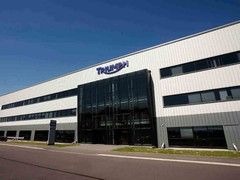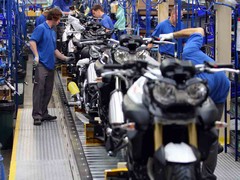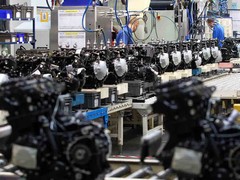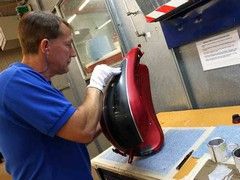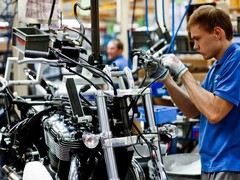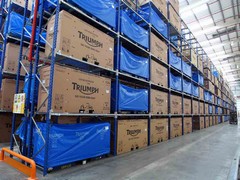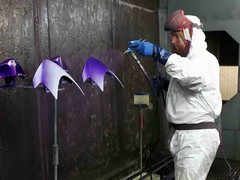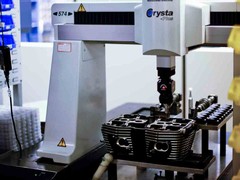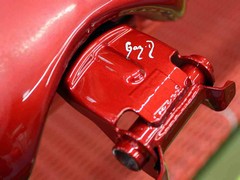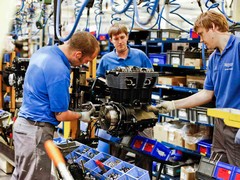PH2 feature: Inside Triumph
Strike up Land Of Hope And Glory - the British bike industry is far from dead and buried!

Having failed to survive the collapse of the British motorcycle industry in the 1970s, Triumph, along with names such as Norton and BSA, found itself plunged into liquidation. Triumph's factory in Meriden was demolished and a housing estate built in its place. Many thought the final page had been reached in the story of Triumph - as it turned out this was just the start of a new chapter.
Having purchased the Triumph name in 1983, housing mogul John Bloor secretly looked into revitalising the brand with a whole new breed of motorcycles, built in a new factory located in Hinckley, Leicestershire. In 1990 his dream came to fruition and six new Triumphs were unveiled to the world.
The key to the success of these new machines was that they were nothing to do with the old 'Meriden' Triumph models. These were brand new machines, not simply re-hashed old models, and they were built using the very latest technology and manufacturing techniques, making the traditional puddle of oil underneath a British bike a thing of the past. Ironically these were skills and lessons learnt from the Japanese factories, the very same companies who had contributed to the death of the British bike industry in the 1970s.
A new breed of Triumphs
Having revitalised the brand, Triumph has grown from the 800 motorcycles sold in its first year to its current figure of over 50,000 units a year, topping the 47,000 a year figure from the 1960s heydays. Triumphs are sold all over the world with a global market share of 5.4 per cent, which is impressive considering it is competing with the might of Honda, Suzuki and Yamaha. What is even more impressive is that one in five bikes over 500cc sold in the UK is a Triumph. This success has been achieved through careful model planning and a huge investment in infrastructure.
As well as two factories in Hinckley, Triumph also owns three facilities in Thailand dedicated to producing parts for its bikes as well as complete machines. There was a slight blip in 2002 when one of the Hinckley factories burnt to the ground, halting production for six months, but that was soon overcome and the rebuilt Factory One now houses office facilities, a paint shop and parts & accessories division. Oddly the insurance insists that no one smokes on the site's grounds...
Inside Triumph
Within the Hinckley Factory Two twin production lines with 80 workers assemble engines while another line with 75 workers takes the finished motors and builds a complete bike around them at the rate of one being every three minutes. Engines are less time consuming - Triumph can build up to 300 engines a day, or one every 1 min 25 sec!
Every day 1,600 individual components are delivered to the production line via a Kanban system that monitors the output and ensures the assembly operators always have a box of bits ready to be fitted to a bike.
All of the plastic panels are painted in a in-house dedicated paint shop and there is also a CNC machine shop that produces finished cranks, cam shafts, engine cases and engine heads as well as a powder coating facility. When completed, up to 7,500 finished bikes can be crated and stacked on shelves that reach to the factory's ceiling ready for delivery to every corner of the world. But they haven't lost the personal touch.
Possibly one of the most telling parts about the Triumph factory is in the paint shop. Triumph understands how much its motorcycles mean to their owners and the pride that they have in their machines, something born out by the paint on the petrol tanks. Any models that have pin-striping (a classic British bike feature) will have the stripe hand painted on by one of two master painters. A machine can't do such intricate work justice, and owners will spot the difference, so to prove it really is hand painted each tank is signed by either Gary or Carl as authenticity of their work using their blue squirrel hair brushes!
Triumph by numbers
500,000 - motorcycles produced so far by 'Hinckley' Triumph
50,000 - motorcycles produced a year
7,500 - maximum number of bikes stored in Hinckley awaiting shipping
755 - Triumph dealerships in the world
600 - employees in the Hinckley factories (190 in R&D)
300 - number of engines built a day
200 - number of bikes built a day
20 - number of models currently in Triumph's range
18.2 per cent - Triumph's share in the UK's motorcycle sales (+500cc)
5.8 per cent - Triumph's share in worldwide motorcycle sales (+500cc)
5 - number of Triumph factories (three in Thailand, two in Hinckley)
3 minutes - a new bike rolls off the production line every three minutes
2 - number of people who paint pinstripes on Triumph's tanks - Carl and Gary
1.25 minutes - a new engine is ready to go every 1 min 25 seconds.
1 - The sole owner of Triumph Motorcycles - John Bloor.
PH2: 2012 Triumph line-up previewed
PH2 Ridden: Triumph Daytona 675R
PH2 Ridden: Triumph Tiger 800/800XC
Gassing Station | Biker Banter | Top of Page | What's New | My Stuff

